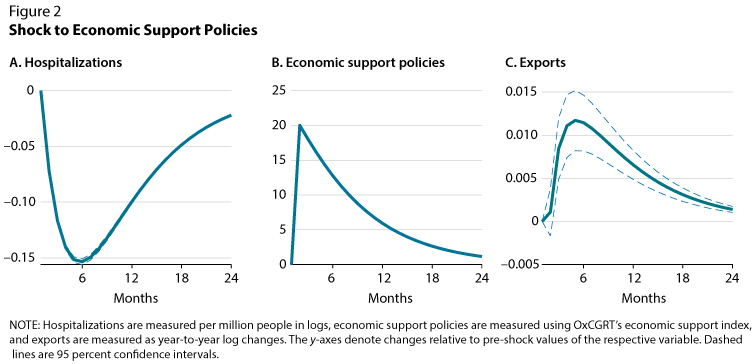The Economic and Epidemiological Impact of COVID-19 and Government Policies: Part 2
Disentangling the effects of COVID-19's spread and containment policies on economic activity is difficult because the disease and containment policies interact with each other. For example, greater spread of COVID-19 is likely to elicit stricter containment efforts designed to curb the disease but that also affect the level of economic activity.
In Part 1 of this series we described the impact of COVID-19's spread on economic activity and government policies.1 In contrast, in this essay we show how government policies impact the spread of COVID-19 and economic activity. In particular, we examine policies aimed at controlling the spread of the virus and economic support policies implemented to mitigate the economic cost of the pandemic.
Both containment and economic policies were intensely debated up to the widespread availability of vaccinations. Health and containment policies were controversial because they were claimed to lower economic activity to prevent the spread of COVID-19, but their ability to curb the disease was not fully known. And evaluating the trade-off between health and the economy was difficult in real time. Likewise, people asked whether economic support policies were generous enough to address the economic cost of the pandemic or overly generous and too costly.
In Famiglietti and Leibovici (2021), we use a statistical model to tease out how COVID-19's spread, government policies, and economic activity affect each other. We do this by looking at cross-state variation in the intensity of, timing of, and response to the pandemic. For example, we exploit the fact that some states increased health containment measures after a rise in COVID-19 infections and compare the path of COVID-19's spread and economic activity in that state with states that left policy unchanged.

Figure 1 plots how COVID-19's spread and economic activity responded to a sharp tightening of government health containment policies. We consider a 20-point increase of the health and containment index from the Oxford COVID-19 Government Response Tracker (OxCGRT), which captures policies such as mask mandates, workplace and school closings, and travel restrictions, among others.2 For context, the average value of this index across states from March-November 2020 was 49, remaining between 33 and 65 in most states over this period; so, a 20-point rise is a large increase in health containment policies. Panel B of Figure 1 plots the tightening of the health containment policies we consider.
Panel A of Figure 1 shows that a 20-point increase in health containment policies reduces COVID-19 hospitalizations by 60 percent within a few months. This result implies that the combination of containment policies implemented successfully reduced the spread of the virus in 2020.
While health containment policies limited COVID-19's spread, they were nevertheless costly. Panel C of Figure 1 shows that a 20-point increase in health containment policies reduces exports, our measure of economic activity, by approximately 7 percent in the month after their implementation. But the response is short lived: Exports rapidly recover and within a year are unaffected by the initial policy.
However, health containment policies were not implemented in isolation: State governments often simultaneously introduced economic support policies to mitigate the economic cost of the virus. Examples of these policies range from expanding unemployment insurance to enacting moratoriums on rent or mortgage payments. OxCGRT's economic support index captures the intensity of these policies.

Figure 2 plots the responses of COVID-19's spread and economic activity to a large (20 point) increase in the economic support index. The change in economic support policies is plotted in Panel B.
Panel A of Figure 2 shows that a 20-point increase in the economic support index reduces COVID-19 hospitalizations by 15 percent within five months. This finding suggests that financial benefits to encourage people to remain at home and replace lost labor income were also effective in reducing the spread of COVID-19.
Panel C of Figure 2 shows that economic policies lead to a 1 percent increase in exports six months after implementation. Thus, these policies succeeded in both reducing COVID-19's spread and stimulating the economy. Economic support to encourage contact-intensive sectors to temporarily shut down might have led to increased economic activity in less-contact-intensive sectors such as those that produce goods more likely to be exported.
In conclusion, our recent working paper allows us to identify how different types of government policies implemented throughout the pandemic have affected the spread of COVID-19 and economic activity. We find that health and containment policies greatly reduced the spread of COVID-19 but at the cost of reducing economic activity. However, economic support policies successfully complemented these policies, further reducing the transmission of COVID-19 while helping to stimulate the economy.
Notes
1 Famiglietti, Matthew and Leibovici, Fernando. "The Economic and Epidemiological Impact of COVID-19 and Government Policies: Part 1." Federal Reserve Bank of St. Louis Economic Synopses, 2021, No. 14.; https://research.stlouisfed.org/publications/economic-synopses/2021/07/01/the-economic-and-epidemiological-impact-of-covid-19-and-government-policies-part-1.
2 See https://www.bsg.ox.ac.uk/research/research-projects/covid-19-government-response-tracker.
© 2021, Federal Reserve Bank of St. Louis. The views expressed are those of the author(s) and do not necessarily reflect official positions of the Federal Reserve Bank of St. Louis or the Federal Reserve System.


 follow @stlouisfed
follow @stlouisfed